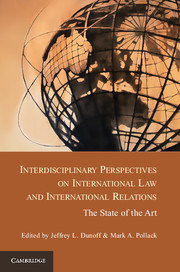 Interdisciplinary Perspectives on International Law and International Relations
Interdisciplinary Perspectives on International Law and International Relations Book contents
- Frontmatter
- Contents
- Contributors
- Acknowledgments
- Part I Introduction: Setting the Stage
- Part II Theorizing International Law
- Part III Making International Law
- Part IV The Interpretation and Application of International Law
- 14 The Multiple Roles of International Courts and Tribunals
- 15 The Design of Dispute Settlement Procedures in International Agreements
- 16 Whose Agents? The Interpretation of International Law in National Courts
- 17 International Judicial Independence
- 18 The Politics of Treaty Interpretation
- Part V Enforcement, Compliance, and Effectiveness
- Conclusions
- Index
- References
17 - International Judicial Independence
Published online by Cambridge University Press: 05 January 2013
- Frontmatter
- Contents
- Contributors
- Acknowledgments
- Part I Introduction: Setting the Stage
- Part II Theorizing International Law
- Part III Making International Law
- Part IV The Interpretation and Application of International Law
- 14 The Multiple Roles of International Courts and Tribunals
- 15 The Design of Dispute Settlement Procedures in International Agreements
- 16 Whose Agents? The Interpretation of International Law in National Courts
- 17 International Judicial Independence
- 18 The Politics of Treaty Interpretation
- Part V Enforcement, Compliance, and Effectiveness
- Conclusions
- Index
- References
Summary
Judicial independence strikes at the heart of what is different about a world with international courts (ICs). International courts have issued more than thirty thousand legally binding judgments (Alter 2013). Yet, if international judges were simply “diplomats in robes,” then these judgments would be unlikely to result in noticeable changes in the policies and practices of states, even if compliance were perfect.
There is a scholarly consensus that most international courts enjoy a degree of autonomy within a defined sphere. The literature refers to this alternately as “constrained independence” (Helfer and Slaughter 2005), “bounded discretion” (Ginsburg 2005), or the “strategic space” (Steinberg 2004) within which international judges can freely operate. There is, however, little agreement on who or what defines the bounds of this sphere or how wide it is or should be. Some argue that the effective control that states exercise over judges is so minute that international judges should properly be considered “trustees” (Majone 2001; Alter 2008). Others question the degree to which ICs do or should enjoy independence (Posner and Yoo 2005; Carrubba, Gabel, and Hankla 2008). Moreover, there are theoretical debates about why ICs acquired the independence that they did.
- Type
- Chapter
- Information
- Interdisciplinary Perspectives on International Law and International RelationsThe State of the Art, pp. 421 - 444Publisher: Cambridge University PressPrint publication year: 2012
References
- 2
- Cited by


